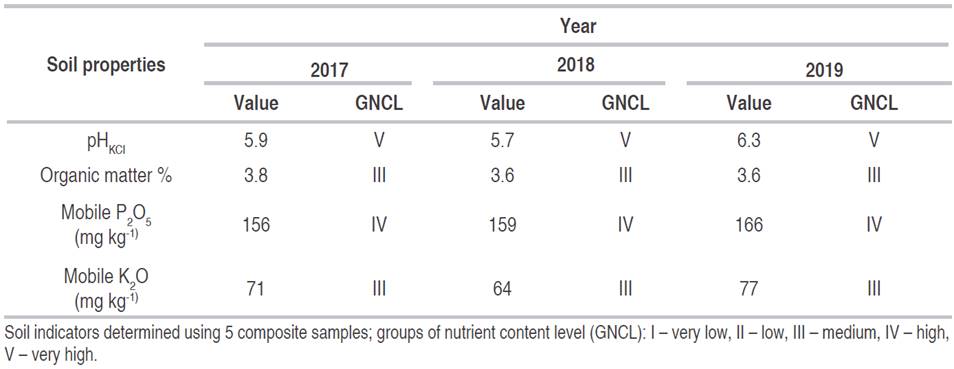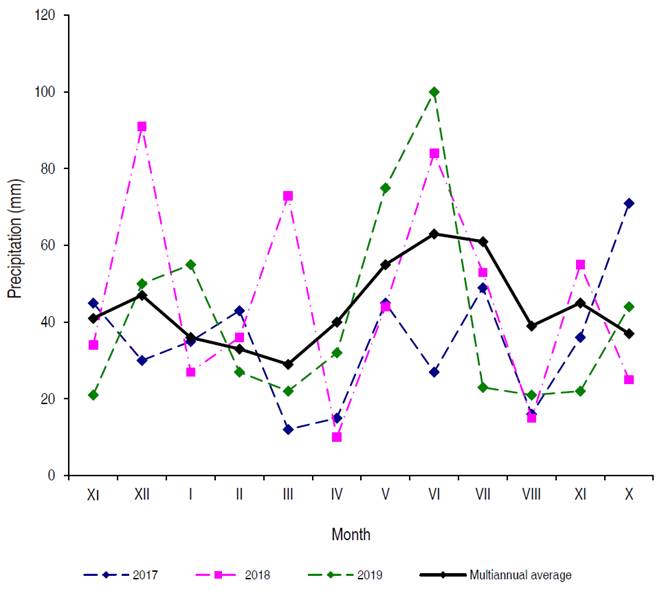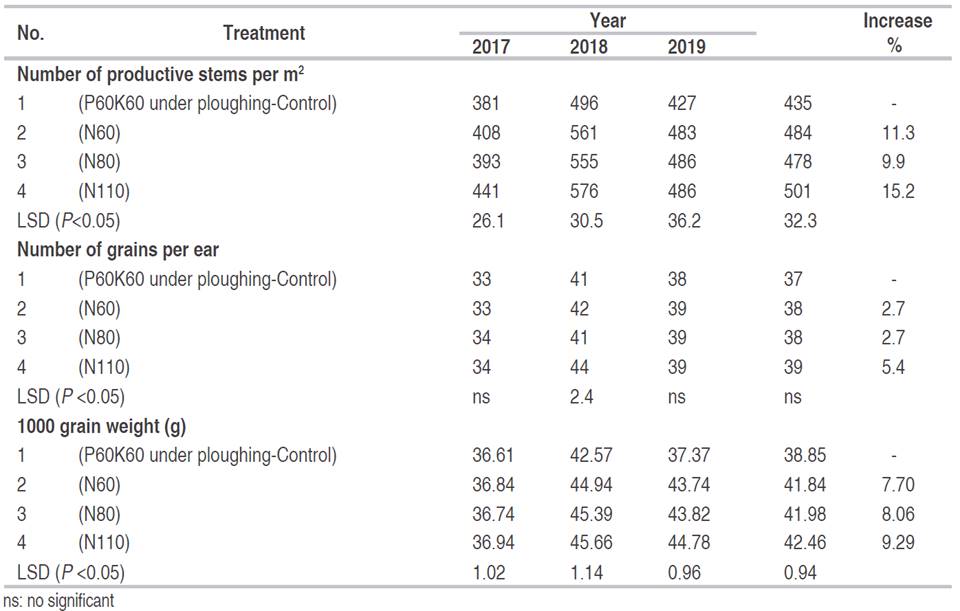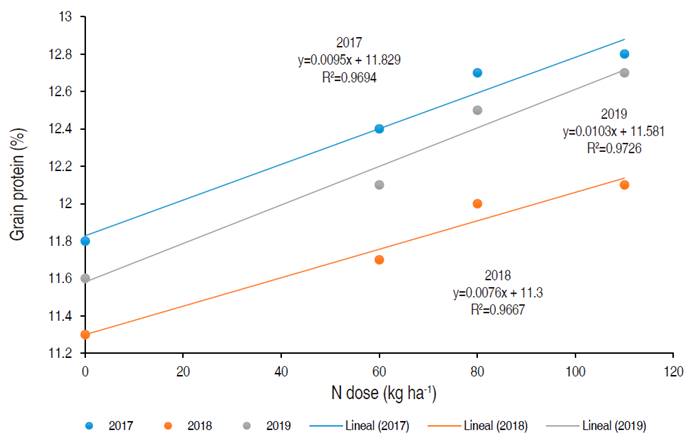Winter wheat (Triticum aestivum L.) is the most common cereal in Ukraine with a cultivation area over 7.0 million ha with an annual grain harvest ranging 25-28 million t (APK-Inform Ukraine, 2020). It is grown in all soil-climatic zones of Ukraine, but the largest areas concentrated in the Forest-steppe and steppe zones, are the areas of highly productive black soils. Although the natural fertility of these soils remains quite high, significant climatic changes in the direction of increasing aridity have posed new challenges to the effectiveness of nutrients, especially nitrogen fertilizers under this crop.
The yield and quality of winter wheat grain strongly depends on the amount and application settings of nitrogen during the growing season. The greatest efficiency of nitrogen fertilizers for winter wheat is achieved when they are applied 3-4 times during the growing season in small doses about 20-60 kg ha-1 The nitrogen application is related to the most crucial phases of the plant growth and development such as sowing, mid-tillering, stem elongation, and grain filling (Abedi et al., 2011; Haile et al., 2012; Efretue et al., 2016). According to Haile et al. (2012) and Liu et al. (2019), the highest productivity of winter wheat is achieved when 120 kg ha-1 nitrogen rate was applied in three stages: 25% at sowing, 50% at mid-tillering, and 25% at anthesis.
However, there is not conclusive evidence of how suitable could be this technique with new challenges of climate warming. Krivenko (2018) and Gengalo et al. (2019) revealed that in the recent years winter wheat has been exposed to dry weather in autumn, leading in a poor tillering of the plants during that season; therefore, in spring, winter wheat requires fertilization with nitrogen in the earliest-term to accelerate regeneration processes. The efficient technique to provide winter wheat plants with accessibly consumable nitrogen in early spring is an application of ammonium nitrate or ammonium sulfate to the surface of frozen soil (Savchenko and Miroshnichenko, 2013). According to Efretue et al. (2016), early spring application of nitrogen to winter wheat in Ireland contributed to increased grain yields, yet with the first nitrogen treatment, the early stem elongation stage (BBCH 31-Biologische Bundesanstalt, Bundessortenamt und CHemische Industrie) was delayed to led to lower yields. Although the efficacy of early nitrogen treatment is evident, it is mainly based on practical experience with limited research data regarding optimal doses and forms of nitrogen application for this crop.
Other effective instruments to improve winter wheat yield and grain quality are the treatment through the leaves with amide nitrogen, which carried out in the stages of stem elongation and grain filling (Abedi et al., 2011; Efretue et al., 2016; Staugaitis et al., 2017; Liu et al., 2019). Under dry weather conditions, the foliar fertilization with the nitrogen can reduce the stress caused by climatic factors; therefore, some researchers consider it as an urgent and effective since this treatment influences plants favorably and increases the productivity of winter wheat despite the environmental change (Ahmed et al., 2011; Rahman et al., 2014; Mandic et al., 2015; Walsh et al., 2018). According to Wagan et al. (2017), foliar feeding of winter wheat with 5% urea solution at the stage of stem elongation contribute to the highest number of grains per spike, the highest value of seed index generating the highest grain yield. Improvement in grain filling stage is attributed to later urea foliar application on winter wheat, leading an effect on grain protein content, which depends on the amount of urea applied (Gholami et al., 2011).
Many opinions have been said concerning the optimal nitrogen rate for winter wheat (between 70 and 120 kg ha-1) and the optimal method of appliance throughout the growing season (Abedi et al., 2011; Mandic et al., 2015; Rasmussen et al., 2015; Walsh et al., 2018; Yi et al., 2015). A study carried out in Serbia showed that nitrogen rate for winter wheat of 75 kg ha-1 maximized the profitability and minimized negative environmental impacts caused by nitrogen loss in the ecosystem, whereas the increase of nitrogen rate to 150 kg ha-1 did not lead to a significant cost-effective ratio (Mandic et al., 2015).
Soil fertility status and climate conditions have been changed during the last decades, affecting also, the way how the nitrogen application for winter wheat have been performed. Therefore, strategies for plant nutrition with nitrogen must be generated based on research results obtained from a local environment. This study aimed to establish the optimal nitrogen rate for winter wheat that was applied in different configurations on leached black soil in Ukraine, and to determine the effectiveness of nitrogen application to the frozen soil surface in early spring as a basis for these fertilizations.
MATERIALS AND METHODS
The experiment was carried out in 2017-2019 at the Bila Tserkva Research-Breading Station of the Institute of Bioenergy Crops and Sugar Beet, Ukraine. A randomized experimental design was used with the main plot size: 33 m2 drilling area, 25 m2 harvested area (Dospekhov, 1985). All treatments were replicated four times. Winter wheat Yasochka cv was sown on September 26-2017, September 21-2018 and October 7-2019.
The soil of the experimental site was leached black soil (Mollisol), loamy texture. Soil samples were taken from 0-30 cm soil layer of every replication to analyze pH, organic matter, mobile phosphorus and potassium before winter wheat was drilled in September. Soil pH was determined in 1 N KCl extraction using a potentiometric method (DSTU ISO 10390-2007), organic matter by Tiurin (DSTU 4289-2004), mobile P2O5 and K2O by Chirikov (DSTU 4115-2002). Agrochemical properties of the soil are presented in Table 1.
Winter wheat was fertilized according to the following scheme: treatment 1. control, no nitrogen; phosphorus as superphosphate and potassium as chloride potassium at 60 kg ha-1 dose of each applied on ploughlands in autumn, treatment 2. nitrogen at a dose of 60 kg ha-1 as ammonium nitrate was applied lonely on frozen soil surface in early spring, treatment 3. nitrogen at dose 30 kg ha-1 as ammonium nitrate was applied on the frozen soil surface plus two foliar feeding with urea solution at BBCH 31-32 stage with 30 kg ha-1 nitrogen dose and at BBCH 75-77 with 20 kg ha-1 nitrogen dose, treatment 4. amultiple dose of nitrogen at 60 kg ha-1 applied on the frozen soil surface.
Within the years of the experiment, winter wheat was harvested in July. The plant samples were taken from four spots of each plot within 0.25 m2 before harvesting to determine winter wheat productivity indicators. In each spot, 20 winter wheat plants were sampled to measure the number of productive stems, grain number per ear and 1,000-grain weight. Unhulled ears were detached from stems; the grains were hulled from ears, counted and weighed. The samples were taken in triplicate to assess grain quality indicators. Grain yield of winter wheat and straw yield was expressed under natural moisture. Total nitrogen content in plants was determined using the Kjeldahl method (DSTU 7169-2010), which then was transferred into crude protein content according to GOST 10846-91. Weather data was provided by the methodological station of Bila Tserkva district.
Statistical analysis
The yield and plant biometric data was submitted to an analysis of variance (ANOVA). Differences among the treatments of the experiment assessed by the least significant difference limit (LSD, P<0.05). Correlation-regression analysis was performed to estimate the correlations between nitrogen rate and winter wheat productivity components using software Microsoft Excel, version 2013, (USA).
RESULTS AND DISCUSSION
The weather conditions during the years of research were predominantly favorable for winter wheat cultivation. In 2017-2019, during the growing season of winter wheat, mean daily temperature was significantly higher than long-term average. It exceeded the mean long-term value by 2.2 °C, 1.8 °C, and 3.0 °C in 2017, 2018, and 2019, respectively (Figure 1). Whereas, the rainfall for the growing season was less than long-term average, and an uneven distribution of rains during the vegetation months was presented. Total rainfall for four months (March-July) was 147 mm, 264 mm, and 252 mm in 2017, 2018, and 2019, respectively, with a long-term average over this period of 248 mm (Figure 2).

Figure 1 Mean monthly temperature values during winter wheat growing season (Bila Tserkva Meteorological Station).
Vegetation period in 2017 was warm and dry, followed with a decrease in precipitation of 101 mm. Particularly, dry weather was observed at the stages of tillering (March) and formation of the ear (April) of winter wheat. During these two dry months, a decrease in rainfall was presented regarding long-term average by 42 mm with an increase in mean daily temperature by 7.5 °C. Dry weather was also observed at the stage of maturity of winter wheat (June) with a deficiency of 36 mm and an increase in mean daily temperature of 2.1 °C. Under such dry and hot weather in 2017, the yield of winter wheat was the lowest, with a decrease of 1.5-2.0 t ha-1 regarding three-year average.
The year 2018 was unusual with a month later onset of frosts, which started in January, and heavy rainfall in December of 2017, which was twice higher than long-term average (91 mm); the extra raining had contributed to the accumulation of water in the soil. March of 2018 was unusually cold with a prevailing mean daily temperature of −2.5 °C, which led to the resumption of winter wheat tillering only in April. The growing season of year 2018 was warm and humid. April was accompanied by excessive rainfall (73 mm), exceeding long-term average by 44 mm. Within May-July, rainfall corresponded to long-term average (179 mm) with exceeding mean daily temperature by 7.4 °C. Wet and hot weather in middle spring contributed to intensive tillering and development of winter wheat and provided the highest grain yield during the experimental years.
In 2019, the growing season was extra warm with regular total rainfall. At the time of intensive tillering and formation of the ear (March-April), weather was extremely warm with perennial rainfall of 54 mm the next two months (May-June); warm and humid with mean daily temperature increase of 3.8 °C, precipitation rate increase of 57 mm. Despite hot weather in March-June, winter wheat has developed and matured favourably, reaching grain yield of more than 7.5 t ha-1. The high productivity of winter wheat can be due to the uniform and enough moisture supply of the plants during the growing season.
Investigation results showed that fertilization of winter wheat with nitrogen provided statistically significant increase in the components of its productivity, number of productive stems, number of grains per ear and 1000-grain weight that depended on the weather conditions, the doses and ways of nitrogen was applied.
Nitrogen used for winter wheat had a significant effect on the number of productive stems. According to the average data of 2017-2019, single fertilization of winter wheat with nitrogen at dose of 60 kg ha-1 applied on the frozen surface of the soil in early spring (treatment 2) increased the number of productive stems compared to control without nitrogen (treatment 1) from 435 to 484 per m2 (11.3%); with a total nitrogen dose of 80 kg ha-1 applied in three steps (treatment 3) from 435 to 478 per m2 (9.9%); with a total nitrogen dose of 110 kg ha-1 applied in three steps (treatment 4) from 435 to 501 per m2 (15.2%). A statistically significant increase in the number of productive stems (P<0.05) was observed in all experimental years. Meanwhile, in the years of extra warm and humid spring (2018-2019), fertilization with the nitrogen had a greater effect on number of productive stems than in year 2017 when spring was overly dry. Maximum number of productive stems was achieved when nitrogen applied in split manner at rate of 110 kg ha-1 that included nitrogen dose of 60 kg ha-1 on the frozen soil surface and two foliar feeding with nitrogen at BBCH 31-32 stage with dose of 30 kg ha-1 and BBCH 75-77 stage with dose of 20 kg ha-1. This result showed that under changeable climate, winter wheat favorably responded to multiple treatment with nitrogen during the growing season, but the application of nitrogen on the frozen soil surface in early spring, as a part of this multiple application strategy, generated a strong foundation to ensure maximum quantity of the productive stems number through experimental years (Table 2).
During this experiment, the evaluation of the impact of nitrogen fertilization on the number of grains per ear did not have a statistically significant difference in yield. The effect of the nitrogen had a not significant increase about 2.7-5.4%, compared to the control without nitrogen. However, the number of grains per ear significantly increased from 41 to 44 (7.3%) in 2018 with a total nitrogen dose of 110 kg ha-1 (treatment 4). That year, warm and regular humid in growing season was recorded and the nitrogen rate of 110 kg ha-1 applied in a split manner had an influence on this indicator value.
The weight of 1000 grains had a significant increase after the application of nitrogen during the years 2018-2019. In 2018, it increased with nitrogen treatments by 7.70-9.29%, including the treatment 2 from 42.57 to 44.94 g, the treatment 3 from 42.57 to 45.39 g, and the treatment 4 from 42.57 to 45.66 g. In 2019, an increase of 17.1-19.8% was registered in grain weight after treatment 4 with a maximum value of this indicator of 44.78 g and the control without nitrogen increased 7.41 g. This suggests that the effect of nitrogen fertilization on the weight of 1000 grains is variable and its effectiveness depends on climatic factor as well. In years when there was enough moisture supply during the growing season, nitrogen fertilizers had a significant effect on it.
The strategy of multiple fertilization of winter wheat with nitrogen based on the application of nitrogen to the frozen soil in early spring, can be an effective means to influence the crop productivity components, such as number of productive stems and weight of 1000 grains. Savchenko and Miroshnichenko (2013), Delin and Stenberg (2014) found similar results to this study. They consider that a high efficiency of nitrogen application in early spring, the period of cool weather and low temperatures, can be due to a low microbial activity in the soil, with an insignificant nitrogen loss through emission and leaching, promoting an increase in the nitrogen availability to the plants.
During experiment, the winter wheat yield ranged from 4.22 t ha-1 in 2017 (control without nitrogen), 8.04 t ha-1 in 2018 (nitrogen dose of 110 kg ha-1) with an average yield of the grain of 6.30 t ha-1 during 2017-2019 (Table 3). According to the average data of three years, fertilization of winter wheat with nitrogen in all its configurations had a significant increase of grain yield compared to the control without nitrogen; 21.4% with a single application of nitrogen at 60 kg ha-1 on the frozen surface of the soil in early spring (treatment 2); 24.8% with split three times application of nitrogen at 80 kg ha-1 (treatment 3), and 30.4% with split three times application of nitrogen at 110 kg ha-1 (treatment 4). The maximum yield of winter wheat grain was obtained when nitrogen was applied under split multiple configuration with a rate of 110 kg ha-1, including nitrogen at 60 kg ha-1 on the frozen surface of the soil in early spring as ammonium nitrate and two foliar feeding with urea solutions at BBCH 31-32 with nitrogen dose of 30 kg ha-1 and at BBCH 75-77 with nitrogen dose of 20 kg ha-1 (6.90 t ha-1). In this treatment, yield of grain was higher 7.5% compared with the effect of single nitrogen fertilization in early spring (treatment 2) where no foliar nitrogen application was done (P<0.05). Both fertilizations with the nitrogen to the soil and foliar feeding contributed significantly to an increase in grain yield. Similar data was published by Krivenko (2018), whom optimized rate of nitrogen fertilizers applied to the soil and across the leaves increased the annual crop yield by 15.4-18.7%. The highest grain yield (10.16 t ha-1) of winter wheat was reached in the treatment where foliar fertilizers were supplied in five applications and it agrees with Jankowski et al. (2016) whom noted the importance of multiple foliar fertilization with nitrogen.
In years of regular precipitation during the growing season (2018-2019) nitrogen fertilizers had more effect on winter wheat yield than the year of deficient precipitation (2017). The studies demonstrated that configurations with nitrogen treatment at rate of 60-110 kg ha-1 increased grain yield compared to the control without nitrogen by 20.0-30.5% in 2018, by 33.7-46.2% in 2019, and only by 8.6-11.6% in 2017 when precipitation rate was the lowest.
Thus, maximum efficiency of nitrogen fertilizers that significantly increased winter wheat yield was associated with the years of favourable precipitation and with the strategy of split multiple fertilization, which was built on early term of nitrogen applied in spring. According to the research of Bobrecka-Jamro et al. (2013), Rasmussen et al. (2015), Yi et al. (2015), Walsh et al. (2018) the effectiveness of this fertilization is also attributed to the optimal rate of nitrogen for winter wheat ranging 90 to 120 kg ha-1, which provides maximum economic and environmental benefit.
In all configurations, nitrogen application stimulated the accumulation of protein in winter wheat grain. Nevertheless, a significant increase in protein content in the grain was presented only using the split multiple application of the nitrogen at 80-110 kg ha-1, which included foliar feeding of plants with urea solutions at BBCH 31-32 stages with nitrogen dose of 30 kg ha-1 and at BBCH 75-77 with nitrogen dose of 20 kg ha-1 (treatment 3 and 4). According to the average data of 2017-2019, in these treatments compared to the control without nitrogen, the content of protein in grain was by 6.9-7.8% higher (P<0.05) with absolute value of the indicator of 12.4-12.5% (Table 4). Such an increase was stable through the years of experiment and did not depend on the variations of weather conditions. These data are consistent with a number of studies on the special role of foliar nitrogen treatments for protein accumulation in grain (Gholami et al., 2011; Litke et al., 2018; Wagan et al., 2017; Walsh et al., 2018), the importance of the last treatment (Gholami et al., 2011; Mandic et al., 2015) and the treatment from heading to flowering (Blandino et al., 2016) in increasing grain protein content, and the high efficiency of nitrogen feeding in reducing plant stress caused by hot weather (Mandic et al., 2015). Bhattaet al. (2017) found that the nitrogen rate at the flag leaf stage increased grain protein content by 1.5-8.1%. Thus, research data allows suggesting that feeding winter wheat with nitrogen through the leaves, as a complement application, could be efficient tool to improve quality of winter wheat grain under climate change.
Nitrogen fertilization increased the average of the straw yield by 27.5-39.1% compared to the control without nitrogen (Table 5). Such a significant increase was attributed to all configurations of nitrogen fertilization and was stable through the years of the experiment. Similar data was reported by Abedi et al. (2011) whom determined that enough nitrogen provision of winter wheat during growing season promotes an increase in grain and straw yield of the crop.
After the correlation-regression analysis of data, significant correlation between rate of nitrogen fertilizer and yield of winter wheat was determined. This trend was observed in all years of the experiment (R2=0.996-1.0) (Figure 3). The winter wheat had an increase in nitrogen rate and was capable to produce a higher grain yield in variable climate with extra warm and sometimes dry weather conditions.
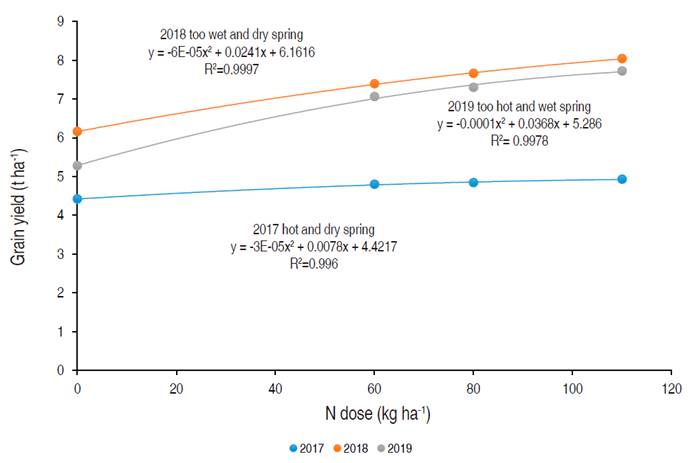
Figure 3 Winter wheat yield according to the annual N rate. 2017 weather was hot and dry spring. 2018 weather was wet and dry spring. 2019 weather was hot and wet spring.
The study showed that with an increase of nitrogen rate, the grain protein content of winter wheat increased (Figure 4). The dependence of protein content on the rate of nitrogen fertilizers was strong (R2=0.967-0.973).
CONCLUSIONS
Nitrogen fertilizer has had a positive effect on winter wheat yield (60-110 kg ha-1) (P<0.05). The highest average grain yield was obtained at a nitrogen rate of 110 kg ha-1 that combined application nitrogen at dose of 60 kg ha-1 on the frozen soil surface in early spring as ammonium nitrate and two foliar feeding with urea solutions at BBCH 31-32 with nitrogen dose of 30 kg ha-1 and BBCH 75-77 with nitrogen dose of 20 kg ha-1 - 6.90 t ha-1. This nitrogen rate and configuration could be an application recommended in order to obtain a great grain yield. In years of regular precipitation during the growing season (2018-2019) nitrogen fertilizers had higher effect on winter wheat yield than the year of precipitation deficiency (2017). Significant increase in grain protein content was obtained in variants where foliar feeding of winter wheat with urea solutions was a part of fertilization strategy; it was attributed to nitrogen rates of 80 and 110 kg ha-1. The increase in protein content of the grain less depended on the weather conditions and was stable through the years of experiment. All configurations of winter wheat fertilization with nitrogen, with an increase in nitrogen rate from 60 to 110 kg ha-1, contributed to the accumulation of protein in the grain. The correlation was evident in all years of the experiment and it had a low dependence on the variations in weather conditions.














